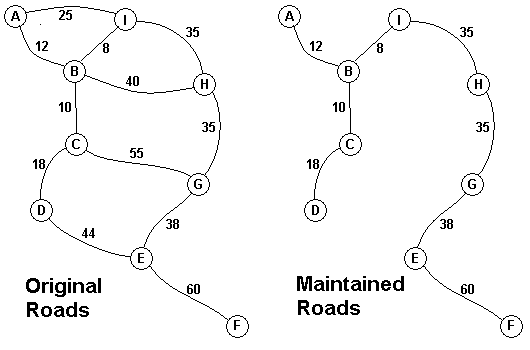一道最小生成树的题。
题目比较基础,不过数据貌似有些不合常规,在看了Discuss之后再结合自己做题的情况,感觉测试数据里的空格有问题,即每个字符和数学之间的空格可能不止一个,所以用scanf(" %c %d",&ch,&k)这种语句可能会有得到RE。
代码(C++):
#include <iostream>
#include <cstdio>
#include <algorithm>
#define MAX_N 30
#define MAX_M 100
using namespace std;
struct Edge{
int a;
int b;
int w;
} edge[MAX_M];
int c,pre[MAX_N];
void add_edge(int a,int b,int w)
{
edge[c].a=a;
edge[c].b=b;
edge[c].w=w;
c++;
}
bool cmp(Edge e1,Edge e2)
{
return e1.w<e2.w;
}
int find(int a)
{
if(pre[a]!=a) pre[a]=find(pre[a]);
return pre[a];
}
void merge(int a,int b)
{
pre[a]=pre[b];
}
int main()
{
//freopen("in.txt","r",stdin);
int n,i,j,k,w,pa,pb,ans;
char ch;
while(scanf("%d",&n)&&n!=0)
{
c=0;
for(i=0;i<n-1;i++) //n-1次
{
//getchar();
//scanf("%c %d",&ch,&k);
cin>>ch;
scanf("%d",&k);
for(j=0;j<k;j++)
{
cin>>ch;
scanf("%d",&w);
add_edge(i,ch-'A',w);
}
}
sort(edge,edge+c,cmp);
ans=0;
for(i=0;i<n;i++) pre[i]=i;
for(i=0;i<c;i++)
{
pa=find(edge[i].a);
pb=find(edge[i].b);
if(pa!=pb)
{
merge(pa,pb);
ans+=edge[i].w;
}
}
printf("%d\n",ans);
}
return 0;
}
题目( http://poj.org/problem?id=1251):
Jungle Roads
| Time Limit: 1000MS | Memory Limit: 10000K | |
Description

The Head Elder of the tropical island of Lagrishan has a problem. A burst of foreign aid money was spent on extra roads between villages some years ago. But the jungle overtakes roads relentlessly, so the large road network is too expensive to maintain. The Council of Elders must choose to stop maintaining some roads. The map above on the left shows all the roads in use now and the cost in aacms per month to maintain them. Of course there needs to be some way to get between all the villages on maintained roads, even if the route is not as short as before. The Chief Elder would like to tell the Council of Elders what would be the smallest amount they could spend in aacms per month to maintain roads that would connect all the villages. The villages are labeled A through I in the maps above. The map on the right shows the roads that could be maintained most cheaply, for 216 aacms per month. Your task is to write a program that will solve such problems.
Input
The input consists of one to 100 data sets, followed by a final line containing only 0. Each data set starts with a line containing only a number n, which is the number of villages, 1 < n < 27, and the villages are labeled with the first n letters of the alphabet, capitalized. Each data set is completed with n-1 lines that start with village labels in alphabetical order. There is no line for the last village. Each line for a village starts with the village label followed by a number, k, of roads from this village to villages with labels later in the alphabet. If k is greater than 0, the line continues with data for each of the k roads. The data for each road is the village label for the other end of the road followed by the monthly maintenance cost in aacms for the road. Maintenance costs will be positive integers less than 100. All data fields in the row are separated by single blanks. The road network will always allow travel between all the villages. The network will never have more than 75 roads. No village will have more than 15 roads going to other villages (before or after in the alphabet). In the sample input below, the first data set goes with the map above.
Output
The output is one integer per line for each data set: the minimum cost in aacms per month to maintain a road system that connect all the villages. Caution: A brute force solution that examines every possible set of roads will not finish within the one minute time limit.
Sample Input
9 A 2 B 12 I 25 B 3 C 10 H 40 I 8 C 2 D 18 G 55 D 1 E 44 E 2 F 60 G 38 F 0 G 1 H 35 H 1 I 35 3 A 2 B 10 C 40 B 1 C 20 0
Sample Output
216 30

























 171
171

 被折叠的 条评论
为什么被折叠?
被折叠的 条评论
为什么被折叠?








